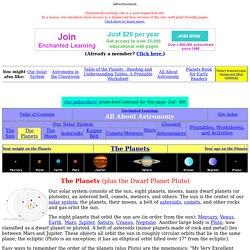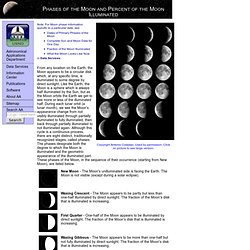

2012 March 12 - The Scale of the Universe Interactive. Discover the cosmos!

Each day a different image or photograph of our fascinating universe is featured, along with a brief explanation written by a professional astronomer. 2012 March 12 The Scale of the Universe - Interactive Flash Animation Credit & Copyright: Cary & Michael Huang Explanation: What does the universe look like on small scales? On large scales? Tomorrow's picture: dust before galaxies Authors & editors: Robert Nemiroff (MTU) & Jerry Bonnell (UMCP)NASA Official: Phillip Newman Specific rights apply.NASA Web Privacy Policy and Important NoticesA service of:ASD at NASA / GSFC& Michigan Tech. Windows to the Universe. StarChild: A Learning Center for Young Astronomers. Explore the planet Mars with realistic Mars habitats, rockets, ground cars and robots. We Choose the Moon: Pre-launch.
Moon - Virtual Tour, Map - Universe - Arounder. Activities for the Classroom. NASA Featured Images and Galleries. Views of the Solar System. Planets - Zoom Astronomy. Advertisement.

EnchantedLearning.com is a user-supported site. As a bonus, site members have access to a banner-ad-free version of the site, with print-friendly pages.Click here to learn more. (Already a member? Click here.) The Planets (plus the Dwarf Planet Pluto) Our solar system consists of the sun, eight planets, moons, many dwarf planets (or plutoids), an asteroid belt, comets, meteors, and others. The eight planets that orbit the sun are (in order from the sun): Mercury, Venus, Earth, Mars, Jupiter, Saturn, Uranus, Neptune. Easy ways to remember the order of the planets (plus Pluto) are the mnemonics: "My Very Excellent Mother Just Sent Us Nine Pizzas" and "My Very Easy Method Just Simplifies Us Naming Planets" The first letter of each of these words represents a planet - in the correct order. The largest planet is Jupiter. The inner planets are: Mercury, Venus, Earth, and Mars. PlanetQuest Historic Timeline.
Amazing Space. Celestia: Home. Reach the World's GeoGames: The New Way to Teach GeoGraphy. What does it feel like to fly over planet Earth? The Earth/Moon System. .br 1) Use checkboxes (Seconds, Minutes, etc) to choose time interval. "Hours" and "Days" work best for animation. Use slidebar at right to control simulation speed. There are 7 speeds, 3 forward (right), 3 reverse (left) and one neutral (center). The bar is initially set at the slowest forward speed. 2) In top panel, Moon (dark or light gray, depending on phase) and Sun (yellow) are shown 4x too large. 3) Eclipse times are estimates only (good to within a few minutes). 4) Distances and sizes are not to scale 5) There is still a problem with the local time - it does not take into account the shift to/from Daylight Savings Time, and so may be off by an hour. Prs@geol.niu.edu. Lps.swf (application/x-shockwave-flash Object) Moon Phase Images.
Phases of the Moon and Percent of the Moon Illuminated. Copyright Antonio Cidadao.

Used by permission. Click on picture to see large version. From any location on the Earth, the Moon appears to be a circular disk which, at any specific time, is illuminated to some degree by direct sunlight. Like the Earth, the Moon is a sphere which is always half illuminated by the Sun, but as the Moon orbits the Earth we get to see more or less of the illuminated half. During each lunar orbit (a lunar month), we see the Moon's appearance change from not visibly illuminated through partially illuminated to fully illuminated, then back through partially illuminated to not illuminated again.
New Moon - The Moon's unilluminated side is facing the Earth. Waxing Crescent - The Moon appears to be partly but less than one-half illuminated by direct sunlight. First Quarter - One-half of the Moon appears to be illuminated by direct sunlight. Waxing Gibbous - The Moon appears to be more than one-half but not fully illuminated by direct sunlight. Lunation Movie. StarChild: Multidisciplinary Solar System Activities: Moonlight Madness. Lockheed Martin Space Day - The Phaser.